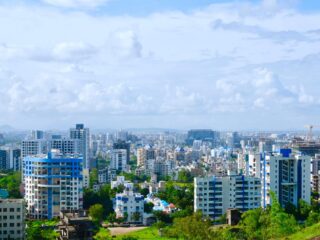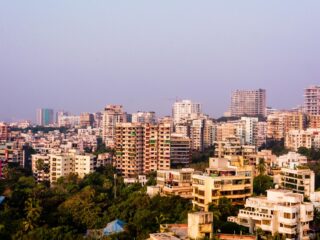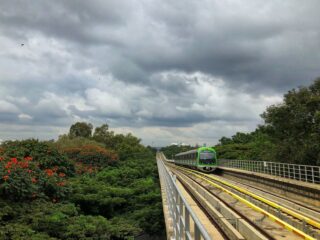Table of Contents
Welcome to Mumbai. The most common mode of transport used by the people in the city are the local trains, the lifeline of Mumbai. The cost of living in Mumbai is high, which is why people do not mind spending even 4 hours commuting to their workplace or college. Travelling by local trains can seem a bit daunting, but with these tips you’ll master the art soon. Eventually you’ll get so used to it, you’ll call yourself a pro. Are you ready to begin your journey? Here’s a guide with everything you need to know!
The routes are divided into 3 lines: Western, Central and Harbour and these tips are applicable to all of them.
1. E-tickets
Reach a ticket counter anytime and you’ll be caught up in a long queue. If you’re running late it could be worse. The best way to avoid all of it is to book tickets online through the UTS app. Either book paperless tickets or tickets you can print at the ATVM machines at the stations. You can also get yourself a smart card using which you can book your tickets through the ATVM machine and skip the queue. This is perfect for those not travelling frequently. If you are a daily traveller, get yourself a monthly, quarterly or yearly pass that will save you both money and time.
Also note that you cannot be at a station without a ticket, even if you’re not boarding a train, you will require a platform ticket.
2. M-indicator
M-indicator is a mobile application that is a blessing for everyone travelling by local trains. You can check train schedules, ticket fares and also track where the train is. It also tells you which platform the train will halt on and provides travel routes to your destination. There is also a train chat option, where users discuss train schedules, notify about problems and any other queries. The app notifies users when there will be a Mega block (track maintenance). This app is really helpful for anyone travelling in Mumbai. Apart from locals, you can get information about BEST buses, ferries, metro, outstation trains and much more.
3. Ladies, General and Handicapped Compartments
A train is divided into various compartments for the ease of its travellers. There are 4 ladies compartments (including the first class). This is for the comfort and safety of female passengers travelling, especially during peak hours. While some are 24hr ladies only, the others allow men after 11pm till 5am.
There is also a handicapped compartment for people with disabilities and is indicated with a sign and a beep sound on the platform. People diagnosed with cancer and women in advanced stages of pregnancy are also allowed to travel in this compartment. Anyone else found travelling can be fined.
The general compartments include 3 general first class and the rest are second class compartments. Anyone can travel in it. It is not a men’s compartment. But it is better for women to avoid using it when it is extremely crowded.
4. First class and AC locals
Your regular 12 coach train will be divided into First Class and Second Class. There are 3 General First Class and One Ladies First Class. If you’re travelling during peak hours, you won’t see much difference in the amount of crowd there, sometimes it can be more due to fewer compartments. But if you travel during non peak hours or on a holiday you’ll get empty first class compartments, while the second class will be crowded(not peak hour crowd)
First class passengers do not have to wait in the queue for booking a ticket or pass and can directly go to the counter. If anyone asks just tell them you are booking a first class ticket. The first class has cushioned seats and the compartment has stripes painted on the outside along with “I” written.
The prices of first class tickets can be more than 10 times that of a second class ticket. The price differs as per the distance. A first class pass is cheaper than buying a ticket everyday and is around 3 times the price of a second class pass. If you’re a student, you can get a concession on the first class pass by filling a form in your respective college. The benefits totally depend on the time you travel at.
There are also AC locals available at certain timings. The cost of the tickets are higher than that of first class and the trains are always empty.
5. Fast and slow trains
There are both fast and slow trains. Fast trains are those that halt only at certain stations. Slow trains on the other hand halt at every station. The indicator will display F and S respectively. There are also semi fast trains, that are fast up to a particular station and slow after that. Before boarding a fast train make sure it halts at the station you want to get off at.
The indicator displays “destination- scheduled time- F / S- expected in minutes” in that particular order. For example “Bo 8:42 F 03” (destination Borivali, 8:42 Fast train, expected in 3 minutes)
6. Peak hours
While travelling try avoiding the peak hours. This is between 8 am to 10 am(towards Churchgate and CST) and between 5 pm to 7 pm(towards Virar and Thane). This is usually when everyone leaves for and from work and getting caught up in this rush hour is horrible. It is not an exaggeration. And if you’re new to the city, be sure to skip around 3-4 trains at this time till you finally push your way through. The trains are overcrowded and people hang right outside. You want to avoid this as much as you can.
If you have to travel at this time, DO NOT get into the compartments near the ladies first class. Always opt for the middle compartments, or the ones at the beginning in the direction the train is heading. These compartments usually tend to be a little less crowded.
7. Ask Questions
Think of this as a golden rule. Always ask. Ask people where they’re getting off and make sure the one ahead has the same destination as you or be ready to reach a few stations ahead while people behind you yell at you.
If you want a seat, ask people where they will be getting off and claim the seat. Tell them you will sit there next. You cannot expect to get a seat without claiming one. It may seem weird at the start, but you’ll get used to it.
Ask people around you if you’re confused. The people selling at the stalls are aware about everything and will help you. It’s better to ask more than one person to be sure.
8. Virar locals (western line only)
Virar locals are a nightmare during rush hours for anyone travelling on the Western line, if you’re not getting off beyond Borivali. Trying to get off at Andheri or Borivali is quite a task, speaking from personal experience. You will be asked why you couldn’t take a Borivali local and will be allowed to get off with great difficulty. So it would be great if you avoid boarding Virar locals during rush hours if you plan to get off before Borivali.
9. Unspoken Rules
Bags
Bag in the front always. This makes sure that all your belongings are safe. Locals and platforms are crowded, and having an eye on your bag is necessary. This is also important to ensure that your bag doesn’t get in the way of yourself or others while getting on or off. Keeping your bag behind may be a hindrance for anyone trying to get in after you and also it may get stuck while you’re trying to get off.
Stand on the correct side
While travelling during rush hour, make sure you stand on the side from where people will be getting off. They usually leave space for people getting in and you do not want to be blocked by that crowd. Don’t forget to confirm if the person ahead is getting off at the same station as you!
10. Confusing platforms and station names
Stations that have multiple lines running can sometimes be confusing. For example Dadar western line and central line have different platforms with the same numbers. So make sure you’re at the right place to board the right train.
Other confusing things can be stations with similar names on different lines. For example the station Matunga Road is on the western line while Matunga is on the central line. Similarly Lower Parel is on the western line and Parel on the central line, and no they’re not the same, in fact to reach Parel from the western line you have to get off at Prabhadevi and use the bridge to get to the Central line. Yep! It’s confusing. Also, keep in mind names of stations that have changed, some people may still refer to them using the old names.
Hope this gives you some insight on what it’s like travelling by local trains. You’ll learn as you travel and you’ll learn everyday. Try ignoring small faults and avoid getting into unnecessary fights(especially with ladies) Don’t hesitate to ask people even the silliest detail if you’re confused!
Travel safe!








